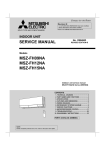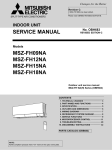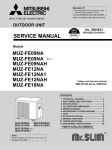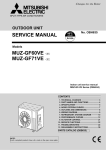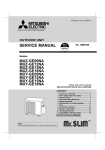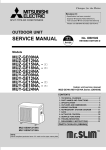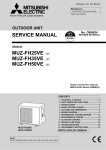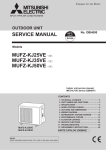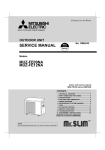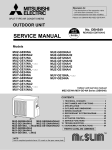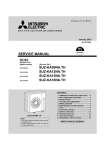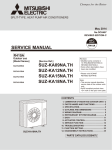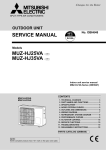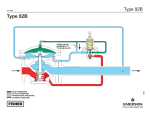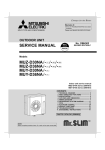Download SERVICE MANUAL
Transcript
Revision A:
• 3. SPECIFICATION has been modified.
• 10. TROUBLESHOOTING has been modified.
Please void OBH684.
SPLIT-TYPE AIR CONDITIONERS
OUTDOOR UNIT
SERVICE MANUAL
No. OBH684
HFC
REVISED EDITION-A
utilized
R410A
Models
MUZ-FH09NA
MUZ-FH12NA
MUZ-FH15NA
MUZ-FH09NAH
MUZ-FH12NAH
MUZ-FH15NAH
Indoor unit service manual
MSZ-FH•NA Series (OBH683)
CONTENTS
1. TECHNICAL CHANGES ··································· 2
2. PART NAMES AND FUNCTIONS ····················· 3
3. SPECIFICATION ················································ 4
4. OUTLINES AND DIMENSIONS ························ 6
5. WIRING DIAGRAM············································ 8
6. REFRIGERANT SYSTEM DIAGRAM ··············11
7. DATA ································································ 13
8. ACTUATOR CONTROL ··································· 21
9. SERVICE FUNCTIONS ··································· 22
10. TROUBLESHOOTING ····································· 23
11. DISASSEMBLY INSTRUCTIONS ···················· 44
MUZ-FH09NA MUZ-FH09NAH
MUZ-FH12NA MUZ-FH12NAH
NOTE:
RoHS compliant products have <G> mark on the spec name plate.
PARTS CATALOG (OBB684)
Use the specified refrigerant only
Never use any refrigerant other than that specified.
Doing so may cause a burst, an explosion, or fire when the unit is being used, serviced, or disposed of.
Correct refrigerant is specified in the manuals and on the spec labels provided with our products.
We will not be held responsible for mechanical failure, system malfunction, unit breakdown or accidents caused by
failure to follow the instructions.
Revision A:
• 3. SPECIFICATION has been modified.
(The values of COP have been modified.)
• 10. TROUBLESHOOTING has been modified.
1
TECHNICAL CHANGES
MUZ-FH09NA
MUZ-FH12NA
MUZ-FH15NA
MUZ-FH09NAH
MUZ-FH12NAH
MUZ-FH15NAH
1. New model
OBH584A
2
2
PART NAMES AND FUNCTIONS
MUZ-FH09NA MUZ-FH12NA
MUZ-FH09NAH MUZ-FH12NAH
Air inlet
(back and side)
Piping
Air outlet
Drain hose
Drain outlet
MUZ-FH15NA
MUZ-FH15NAH
Air inlet
(back and side)
Piping
Drain hose
Air outlet
Drain outlet
OBH584A
3
3
SPECIFICATION
Outdoor unit model
Capacity
Cooling 1
Rated (Minimum~Maximum)
Heating 47 1
Btu/h
Btu/h
Capacity
Heating 17 2
Btu/h
Rated (Maximum)
MUZ-FH09NA
MUZ-FH12NA
MUZ-FH15NA
MUZ-FH09NAH
MUZ-FH12NAH
MUZ-FH15NAH
9,000 (1,700 ~ 12,000) 12,000 (2,500 ~ 13,600) 15,000 (6,450 ~ 19,000)
10,900 (1,600 ~ 18,000) 13,600 (3,700 ~ 21,000) 18,000 (5,150 ~ 24,000)
6,700 (12,200)
8,000(13,600)
11,000 (18,000)
Heating 47 1
W
W
560 (100 ~ 1,000)
710 (110 ~ 1,470)
870 (170 ~ 1,150)
950 (280 ~ 2,300)
1,200 (410 ~ 2,200)
1,300 (430 ~ 3,360)
Power consumption Heating 17 2
W
600 (1,440)
720 (1,900)
1,020 (2,480)
16.1 [30.5]
NA: 13.5
NAH: 12.5
4.50
13.8 [26.1]
NA: 12.5
NAH: 11.5
4.20
208/230, 1 , 60
12.5 [22.0]
NA: 12.0
NAH: 11.0
4.06
Power consumption Cooling 1
Rated (Minimum~Maximum)
Rated (Maximum)
EER 1 [SEER] 3
Cooling
HSPF IV 4
Heating
COP
Heating 1
Power supply
Max. fuse size (time delay)
Min. circuit ampacity
Fan motor
Model
Compressor
V , phase , Hz
A
A
F.L.A
15
11
0.50
SNB092FQAMT
R.L.A
L.R.A
Refrigeration oil L (Model)
0.35 (FV50S)
Refrigerant control
Sound level 1
Cooling
Heating
dB(A)
dB(A)
W
D
H
in.
in.
in.
Ib.
48
49
Defrost method
Dimensions
Weight
External finish
Remote controller
Control voltage (by built-in transformer)
Refrigerant piping
Liquid
Refrigerant pipe size
(Min. wall thickness)
Gas
Indoor
Connection method
Outdoor
Between the indoor Height difference
& outdoor units
Piping length
Refrigerant charge (R410A)
SNB140FQUMT
8.2
10.3
81
VDC
in.
in.
ft.
ft.
0.35 (FV50S)
Linear expansion valve
49
51
Reverse cycle
31-1/2
11-1/4
21-5/8
83
Munsell 3Y 7.8/1.1
Wireless type
12 - 24
Not supplied
1/4 (0.0315)
3/8 (0.0315)
Flared
Flared
40
65
2 lb. 9 oz.
NOTE: Test conditions are based on AHRI 210/240.
1: Rating conditions (Cooling) — Indoor: 80˚FDB, 67˚FWB, Outdoor: 95˚FDB, (75˚FWB)
(Heating) — Indoor: 70˚FDB, 60˚FWB, Outdoor: 47˚FDB, 43˚FWB
2:
(Heating) — Indoor: 70˚FDB, 60˚FWB, Outdoor: 17˚FDB, 15˚FWB
OBH584A
4
20
16
0.93
SNB172FQKMT
12.0
15.0
0.40 (FV50S)
51
55
33-1/16
13
34-5/8
124
1/2 (0.0315)
50
100
3 lb. 7 oz.
Test condition
3, 4
ARI
Mode
Indoor air condition (°F)
Dry bulb
Wet bulb
Test
Outdoor air condition (°F)
Dry bulb
Wet bulb
"A-2" Cooling Steady State
at rated compressor Speed
80
67
95
(75)
"B-2" Cooling Steady State
at rated compressor Speed
80
67
82
(65)
SEER "B-1" Cooling Steady State
(Cooling) at minimum compressor Speed
80
67
82
(65)
"F-1" Cooling Steady State
at minimum compressor Speed
80
67
67
(53.5)
"E-V" Cooling Steady State
at Intermediate compressor Speed 5
80
67
87
(69)
"H1-2" Heating Steady State
at rated compressor Speed
70
60
47
43
"H3-2" Heating
at rated compressor Speed
70
60
17
15
"H0-1" Heating Steady State
HSPF
(Heating) at minimum compressor Speed
70
60
62
56.5
"H1-1" Heating Steady State
at minimum compressor Speed
70
60
47
43
"H2-V" Heating
at Intermediate compressor Speed 5
70
60
35
33
5: At Intermediate compressor Speed
= ("Cooling rated compressor speed" - "minimum compressor speed") / 3 + "minimum compressor speed".
OPERATING RANGE
(1) POWER SUPPLY
Rated voltage
Outdoor unit
Guaranteed voltage (V)
208/230 V
1 phase
60 Hz
Min. 187
208
230
Max. 253
(2) OPERATION
Intake air temperature (°F)
Mode
Condition
Standard temperature
Maximum temperature
Cooling
Minimum temperature
Maximum humidity
Standard temperature
Heating Maximum temperature
Minimum temperature
OBH584A
Indoor
Outdoor
DB
80
90
67
WB
67
73
57
DB
95
115
14
60
67
60
47
75
-13
78 %
WB
—
—
—
—
70
80
70
5
43
65
-14
4
OUTLINES AND DIMENSIONS
Unit: inch
MUZ-FH09NA MUZ-FH09NAH MUZ-FH12NA MUZ-FH12NAH
*1 4 in. (100 mm) or more when
front and sides of the unit are clear
clear *1
REQUIRED SPACE
4 in
.(
or 100 m
mo
re m)
)
mm
00
. (2 ore *2
n
i
8 rm
o
14
in.
(
or m350 m
ore m)
*2 When any 2 sides of left, right
and rear of the unit are clear
holes
Liquid refrigerant pipe joint
Refrigerant pipe (flared) Ø 1/4
Gas refrigerant pipe joint
Refrigerant pipe (flared) Ø 3/8
OBH584A
6
)
mm
00 re
1
(
o
n.
4 i or m
Unit: inch
REQUIRED SPACE
*1 20 in. (500 mm) or more when front
and sides of the unit are clear
Clear *1
MUZ-FH15NA MUZ-FH15NAH
16-7/16
Drain hole
1-9/16
)
mm
00
. (1 re
n
i
4 mo
or
1-5/8
4i
or mn. (10
ore 0 mm
)
13
2
14-3/16
Air in
)
mm
500
(
.
2
in
20 ore *
or m
Air out
2-holes 13/32 13/16
6-7/8
19-11/16
14
or min. (35
ore 0 mm
)
*2 When any 2 sides of left, right
and rear of the unit are clear
33-1/16
4-5/16
3-3/16
Service panel
35
17-25/32
34-5/8
Liquid refrigerant pipe joint
Refrigerant pipe (flared) Ø 1/4
6-1/2
3-29/32
44
Gas refrigerant pipe joint
Refrigerant pipe (flared) Ø 1/2
7-11/16
OBH584A
7
5
WIRING DIAGRAM
MUZ-FH09NA MUZ-FH12NA
MUZ-FH09NAH MUZ-FH12NAH
OBH584A
8
MUZ-FH15NA
OBH584A
9
MUZ-FH15NAH
OBH584A
10
6
REFRIGERANT SYSTEM DIAGRAM
Unit: inch
MUZ-FH09NA MUZ-FH09NAH MUZ-FH12NA MUZ-FH12NAH
Refrigerant pipe ø3/8
(with heat insulator)
4-way valve
Muffler
Stop valve
Discharge
temperature
Service thermistor
port
RT62
Flared connection
Outdoor
heat
exchanger
Muffler
Service
port
Outdoor heat
exchanger
temperature
thermistor
RT68
Ambient
temperature
thermistor
RT65
Compressor
Defrost
thermistor
RT61
Capillary tube
O.D. 0.157 ×
I.D. 0.094 × 9-7/16 LEV
(ø4.0 × ø2.4 × 240)
Flared connection
Refrigerant pipe ø1/4
(with heat insulator)
Capillary tube
O.D. 0.118 ×
I.D. 0.079 × 8-9/32
(ø3.0 × ø2.0 × 210)
Strainer
#100
R.V. coil
heating ON
cooling OFF
Stop valve
(with strainar)
Refrigerant flow in cooling
Refrigerant flow in heating
MUZ-FH15NA MUZ-FH15NAH
Muffler
4-way valve #100
Refrigerant pipe ø1/2
(with heat insulator)
Service port
Stop valve
Flared connection
Outdoor
heat
exchanger
Discharge
temperature
Service thermistor
RT62
port
Defrost
thermistor
RT61
Ambient
temperature
thermistor
RT65
Compressor
Outdoor heat
exchanger
temperature
thermistor
RT68
Flared connection
Strainer
#100
Stop valve
Refrigerant pipe ø1/4
(with heat insulator)
OBH584A
LEV
Muffler
Strainer
#100
Capillary tube
O.D. 0.157 ×
I.D. 0.094× 3-15/16
(ø4.0×ø2.4×100)
11
R.V. coil
heating ON
cooling OFF
Refrigerant flow in cooling
Refrigerant flow in heating
MAX. REFRIGERANT PIPING LENGTH and MAX. HEIGHT DIFFERENCE
Model
Refrigerant piping: ft.
Max. Length
Max. Height difference
A
B
Piping size O.D: in.
Gas
Liquid
MUZ-FH09NA
MUZ-FH09NAH
MUZ-FH12NA
MUZ-FH12NAH
65
40
3/8
1/4
MUZ-FH15NA
MUZ-FH15NAH
100
50
1/2
1/4
Indoor
unit
Max. Height
difference
B
Max. Length
A
Outdoor unit
ADDITIONAL REFRIGERANT CHARGE (R410A: oz.)
NOTE: Refrigerant piping exceeding 25 ft. requires additional refrigerant charge according to the calculation.
Refrigerant piping length (one way): ft.
40
50
Model
Outdoor unit
precharged
25
30
MUZ-FH09NA
MUZ-FH09NAH
2 lb. 9 oz.
0
1.08
3.24
5.40
60
65
7.56
8.64
Calculation: X oz. = 1.08/5 oz./ft. × (Refrigerant piping length (ft.) - 25)
NOTE: Refrigerant piping exceeding 25 ft. requires additional refrigerant charge according to the calculation.
Refrigerant piping length (one way): ft.
40
50
Model
Outdoor unit
precharged
25
30
MUZ-FH12NA
MUZ-FH12NAH
2 lb. 9 oz.
0
1.62
4.86
8.10
60
65
11.34
12.96
Calculation: X oz. = 1.62/5 oz./ft. × (Refrigerant piping length (ft.) - 25)
NOTE: Refrigerant piping exceeding 25 ft. requires additional refrigerant charge according to the calculation.
Model
Outdoor unit
precharged
25
30
MUZ-FH15NA
MUZ-FH15NAH
3 lb. 7 oz.
0
1.08
Refrigerant piping length (one way): ft.
40
50
60
70
80
3.24
5.40
7.56
9.72
11.88
90
100
14.04
16.20
Calculation: X oz. = 1.08/5 oz./ft. × (Refrigerant piping length (ft.) - 25)
OBH584A
12
7
DATA
MUZ-FH09NA MUZ-FH09NAH MUZ-FH12NA MUZ-FH12NAH MUZ-FH15NA MUZ-FH15NAH
7-1. PERFORMANCE DATA
1) COOLING CAPACITY
Indoor air
Model
MUZ-FH09NA
MUZ-FH09NAH
MUZ-FH12NA
MUZ-FH12NAH
MUZ-FH15NA
MUZ-FH15NAH
IWB (˚F)
71
67
63
71
67
63
71
67
63
TC
11.0
10.4
9.8
14.7
13.9
13.1
18.4
17.4
16.4
75
SHC
8.7
9.6
10.3
10.2
11.6
12.6
10.4
12.2
13.6
TPC
0.50
0.47
0.45
0.77
0.73
0.70
1.07
1.01
0.96
TC
10.3
9.7
9.1
13.7
13.0
12.1
17.2
16.2
15.2
Outdoor intake air DB temperature (˚F)
85
95
105
SHC TPC TC SHC TPC TC SHC
8.1 0.55 9.7
7.6 0.59 9.0
7.1
8.9 0.52 9.0
8.3 0.56 8.4
7.7
9.6 0.50 8.5
8.9 0.53 7.7
8.1
9.6 0.85 12.9 9.0 0.91 12.0 8.4
10.8 0.80 12.0 10.0 0.87 11.2 9.3
11.7 0.77 11.3 10.9 0.83 10.3 9.9
9.7 1.17 16.1 9.1 1.26 15.0 8.5
11.3 1.11 15.0 10.5 1.20 14.0 9.8
12.6 1.06 14.1 11.8 1.15 12.8 10.7
NOTE: 1. IWB : Intake air wet-bulb temperature
TC
: Total Capacity (x103 Btu/h)
SHC : Sensible Heat Capacity (x103 Btu/h) TPC : Total Power Consumption (kW)
2. SHC is based on 80˚F of indoor Intake air DB temperature.
2) COOLING CAPACITY CORRECTIONS
Refrigerant piping length (one way: ft.)
25 (std.)
40
65
100
MUZ-FH09NA
MUZ-FH09NAH
MUZ-FH12NA
MUZ-FH12NAH
1.0
0.954
0.878
-
MUZ-FH15NA
MUZ-FH15NAH
1.0
0.954
0.878
0.771
OBH584A
13
TPC
0.62
0.59
0.57
0.96
0.92
0.89
1.33
1.27
1.22
115
TC SHC TPC
8.3
6.5 0.64
7.7
7.1 0.62
7.0
7.4 0.59
11.0 7.7 1.00
10.3 8.5 0.97
9.4
9.0 0.92
13.8 7.8 1.38
12.8 9.0 1.33
11.7 9.8 1.27
3) HEATING CAPACITY
Indoor air
Model
MUZ-FH09NA
MUZ-FH09NAH
MUZ-FH12NA
MUZ-FH12NAH
MUZ-FH15NA
MUZ-FH15NAH
IDB (˚F)
75
70
65
75
70
65
75
70
65
75
70
65
75
70
65
75
70
65
5
TC
4.8
5.2
5.5
4.8
5.2
5.5
6.0
6.5
6.8
6.0
6.5
6.8
7.9
8.6
9.0
7.9
8.6
9.0
15
TPC
0.42
0.40
0.38
0.55
0.53
0.51
0.56
0.54
0.51
0.69
0.67
0.64
0.77
0.73
0.70
0.90
0.86
0.83
TC
6.3
6.7
6.9
6.3
6.7
6.9
7.9
8.4
8.6
7.9
8.4
8.6
10.4
11.1
11.3
10.4
11.1
11.3
TPC
0.53
0.51
0.49
0.66
0.64
0.62
0.71
0.68
0.66
0.84
0.81
0.79
0.97
0.94
0.90
1.10
1.07
1.03
Outdoor intake air WB temperature (˚F)
25
35
43
TC TPC TC TPC TC TPC
7.9 0.62 9.4 0.69 10.6 0.73
8.2 0.61 9.6 0.67 10.9 0.71
8.6 0.59 10.0 0.66 11.2 0.69
7.9 0.75 9.4 0.69 10.6 0.73
8.2 0.74 9.6 0.67 10.9 0.71
8.6 0.72 10.0 0.66 11.2 0.69
9.9 0.83 11.8 0.93 13.3 0.97
10.2 0.81 12.0 0.90 13.6 0.95
10.7 0.78 12.4 0.88 14.0 0.93
9.9 0.96 11.8 0.93 13.3 0.97
10.2 0.94 12.0 0.90 13.6 0.95
10.7 0.91 12.4 0.88 14.0 0.93
13.1 1.14 15.6 1.27 17.6 1.33
13.5 1.11 15.9 1.24 18.0 1.30
14.1 1.07 16.5 1.20 18.5 1.27
13.1 1.27 15.6 1.27 17.6 1.33
13.5 1.24 15.9 1.24 18.0 1.30
14.1 1.20 16.5 1.20 18.5 1.27
45
TC
11.0
11.2
11.6
11.0
11.2
11.6
13.7
14.0
14.4
13.7
14.0
14.4
18.1
18.5
19.1
18.1
18.5
19.1
55
TPC
0.74
0.72
0.70
0.74
0.72
0.70
0.99
0.97
0.94
0.99
0.97
0.94
1.35
1.33
1.29
1.35
1.33
1.29
TC
12.4
12.7
13.0
12.4
12.7
13.0
15.5
15.8
16.2
15.5
15.8
16.2
20.5
21.0
21.4
20.5
21.0
21.4
TPC
0.77
0.75
0.74
0.77
0.75
0.74
1.03
1.01
0.99
1.03
1.01
0.99
1.40
1.38
1.35
1.40
1.38
1.35
NOTE: 1. IDB : Intake air dry-bulb temperature
TC : Total Capacity (x103 Btu/h)
TPC : Total Power Consumption (kW)
2. Above data is for heating operation without any frost.
How to operate with fixed operational frequency of the compressor.
1. Press the EMERGENCY OPERATION switch on the front of the indoor unit, and select either EMERGENCY COOL
mode or EMERGENCY HEAT mode before starting to operate the air conditioner.
2. The compressor starts with operational frequency.
3. The fan speed of the indoor unit is High.
4. This operation continues for 30 minutes.
5. In order to release this operation, press the EMERGENCY OPERATION switch twice or once, or press any button on
the remote controller.
OBH584A
14
7-2. PERFORMANCE CURVE
Cooling
Capacity correction factors
Indoor air Wet-bulb temperature
difference (°F)
Cooling capacity (at Rated frequency)
1.5
Indoor intake air Wet-bulb
temperature( F)
1.4
1.3
1.2
76
1.1
75
1.0
0.9
14
23
32
41
50
59
68
77
86
95
104
72
68
64
113
Outdoor intake air DB temperature(°F)
MUZ-FH12NA MUZ-FH12NAH
SHF at rating condition = 0.92
Airflow = 381 CFM
0.8
°F)
ture (
0.7
pera
B tem
e air W
r intak
0.6
Indoo
71
67
63
0.5
0.4
65
75
85
95
105
Outdoor intake air DB temperature (°F)
115
Total power consumption
(kW)
Total power consumption
(kW)
MUZ-FH09NA MUZ-FH09NAH
SHF at rating condition = 0.83
Airflow = 398 CFM
1.1
rature
1.0
0.9
r inta
ke air
Indoo
0.8
mpe
WB te
(°F)
71
67
63
0.7
0.6
65
75
85
95
105
Outdoor intake air DB temperature (°F)
115
Total power consumption
(kW)
MUZ-FH15NA MUZ-FH15NAH
SHF at rating condition = 0.7
Airflow = 411 CFM
1.4
71
67
63
1.3
1.2
1.1
WB
ke air
rature
tempe
(°F)
r inta
1.0
Indoo
0.9
65
75
85
95
105
Outdoor intake air DB temperature (°F)
115
This value of frequency is not the same as the actual frequency in operating. Refer to 7-5 and 7-6 for the relationships
between frequency and capacity.
OBH584A
15
Heating
Heating capacity (at Rated frequency)
Capacity correction factor
Indoor air Dry-bulb temperature
difference (°F)
1.3
1.2
e(
tur
ra
pe
1.1
1.0
lb
bu
0.9
ir
ea
ak
0.8
t
r in
yDr
F)
59
68
79
tem
oo
Ind
0.7
0.6
0.5
0.4
5
14
23
32
41
50
Outdoor intake air WB temperature (°F)
MUZ-FH09NA
MUZ-FH09NAH
Total power consumption
(kW)
Airflow = 437 CFM
0.8
65
70
75
0.6
e air
r intak
0.4
re (°F)
peratu
DB tem
Indoo
0.2
-5
5
59
15
25
35
45
55
Outdoor intake air WB temperature (°F)
Airflow = 437 CFM
Total power consumption
(kW)
-4
1.0
0.9
0.7
0.6
F)
rature (°
B tempe
take air D
0.5
Indoor in
0.4
0.3
65
MUZ-FH12NA
75
70
65
0.8
-5
5
15
25
35
45
55
Outdoor intake air WB temperature (°F)
MUZ-FH12NAH
65
70
75
0.9
F)
0.6
ke air
inta
Indoor
re (°
peratu
DB tem
0.3
5
15
25
35
45
55
Outdoor intake air WB temperature (°F)
Total power consumption
(kW)
1.50
65
70
75
1.25
1.00
take
door in
air DB
(°F)
erature
temp
In
5
75
70
65
1.0
0.9
0.8
0.7
Indoor in
F)
rature (°
B tempe
take air D
0.6
0.5
0.4
-5
5
15
25
35
45
55
Outdoor intake air WB temperature (°F)
65
MUZ-FH15NAH
Airflow = 454 CFM
0.50
-5
1.1
65
MUZ-FH15NA
0.75
Total power consumption
(kW)
Airflow = 454 CFM
1.2
15
25
35
45
55
Outdoor intake air WB temperature (°F)
Airflow = 497 CFM
Total power consumption
(kW)
Total power consumption
(kW)
Airflow = 454 CFM
-5
65
65
1.5
75
70
65
1.3
1.1
0.9
take
Indoor in
0.7
re (°F)
mperatu
air DB te
0.5
-5
5
15
25
35
45
55
Outdoor intake air WB temperature (°F)
65
This value of frequency is not the same as the actual frequency in operating. Refer to 7-5 and 7-6 for the relationships
between frequency and capacity.
OBH584A
16
7-3. CONDENSING PRESSURE
Cooling
Data are based on the condition of indoor humidity 50 %.
Air flow should be set to High speed.
MUZ-FH09NA MUZ-FH09NAH
(PSIG)
500
400
re
ratu
)
(°F
pe
350
oor
Ind
m
B te
D
300
250
200
65
70
75
80
85
(PSIG)
190
86
80
75
70
Suction pressure
Condensing pressure
450
90
95
170
80
75
70
150
130
110
90
60
100 105 (°F)
86
rature (°F)
Indoor DB tempe
65
Outdoor ambient temperature
70
75
80
85
90
95
Outdoor ambient temperature
100
105 (°F)
MUZ-FH12NA MUZ-FH12NAH
(PSIG)
500
atu
per
oor
400
Ind
350
300
250
200
65
(PSIG)
180
86
80
75
70
m
te
DB
Suction pressure
Condensing pressure
°F)
re (
450
70
75
80
85
90
95
rature (°F)
80
75
70
140
120
100
80
65
100 105 (°F)
86
Indoor DB tempe
160
70
Outdoor ambient temperature
75
80
85
90
95
Outdoor ambient temperature
100
105 (°F)
MUZ-FH15NA MUZ-FH15NAH
(PSIG)
500
atu
per
oor
400
Ind
350
300
250
200
65
(PSIG)
180
86
80
75
70
m
te
DB
Suction pressure
Condensing pressure
°F)
re (
450
70
75
80
85
90
95
100 105 (°F)
rature (°F)
80
75
70
140
120
100
80
65
70
Outdoor ambient temperature
OBH584A
86
Indoor DB tempe
160
17
75
80
85
90
95
Outdoor ambient temperature
100
105 (°F)
Heating
Data are based on the condition of outdoor humidity 75%.
Air flow should be set to High speed.
Data are for heating operation without any frost.
MUZ-FH09NA MUZ-FH09NAH
(PSIG)
450
(PSIG)
210
370
re
ratu
)
(°F
190
70
65
170
Suction pressure
Condensing pressure
410
75
e
oor
Ind
DB
p
tem
330
)
150
re
(°F
u
at
r
pe
m
130
or
DB
te
o
nd
110
I
90
290
58.5Hz
250
75
70
65
5
15
25
35
45
55
Outdoor ambient temperature
65
58.5Hz
70
75 (°F)
50
5
15
25
35
45
55
Outdoor ambient temperature
65
75 (°F)
MUZ-FH12NA MUZ-FH12NAH
(PSIG)
450
75
70
65
410
°F)
re (
atu
er
mp
370
oor
Ind
B te
D
330
290
5
15
25
35
45
55
Outdoor ambient temperature
65
)
150
re
(°F
u
at
r
pe
m
125
or
DB
te
o
nd
I
100
75
49Hz
250
75
70
65
175
Suction pressure
Condensing pressure
(PSIG)
200
75 (°F)
50
49Hz
5
15
25
35
45
55
Outdoor ambient temperature
65
75 (°F)
MUZ-FH15NA MUZ-FH15NAH
(PSIG)
550
(PSIG)
200
75
70
65
450
°F)
re (
atu
per
m
B te
or D
400
o
Ind
350
300
250
175
Suction pressure
Condensing pressure
500
15
25
35
45
55
Outdoor ambient temperature
OBH584A
65
)
150
B
(°F
t
ra
pe
125
e
ur
m
te
rD
oo
d
In
100
75
50Hz
5
75
70
65
75 (°F)
50
50Hz
5
18
15
25
35
45
55
Outdoor ambient temperature
65
75 (°F)
7-4. STANDARD OPERATION DATA
Model
Item
Unit
Total
Capacity
10,900
12,000
13,600
15,000
18,000
SHF
—
0.92
—
0.83
—
0.70
—
Input
kW
0.560
0.710
0.870
0.950
1.200
1.300
Rated frequency
Hz
47
58.5
46
49
50.5
50
MSZ-FH09NA
Electrical circuit
MSZ-FH12NA
V,
phase,
Hz
Input
Fan motor current
208/230, 1, 60
0.029
0.029
0.031
A
0.30/0.27
MUZ-FH09NA
MUZ-FH09NAH
0.30/0.27
MUZ-FH12NA
MUZ-FH12NAH
0.31/0.28
MUZ-FH15NA
MUZ-FH15NAH
V,
phase,
Hz
Power supply
MSZ-FH15NA
kW
Outdoor unit
Input
208/230, 1, 60
kW
0.531
0.681
0.841
0.921
1.169
1.269
Comp. current
A
2.32/2.10
3.01/2.72
3.60/3.26
4.06/3.67
4.46/4.03
4.87/4.40
Fan motor current
A
0.36/0.33
0.34/0.31
0.41/0.37
0.40/0.36
1.21/1.09
1.24/1.12
Condensing pressure
PSIG
352
323
374
340
361
391
Suction pressure
PSIG
153
110
135
106
131
108
Discharge temperature
˚F
148
145
156
148
152
170
Condensing temperature
˚F
107
101
112
105
109
115
Suction temperature
˚F
64
41
56
36
52
45
Comp. shell bottom temperature
˚F
129
125
137
128
135
147
Ref. pipe length
ft.
25
Refrigerant charge (R410A)
Intake air temperature
Indoor unit
MSZ-FH15NA
Cooling
Heating
9,000
Power supply
Discharge air temperature
2 lb. 9 oz.
DB
˚F
80
70
80
70
80
70
˚F
67
60
67
60
67
60
DB
˚F
58
99
56
101
52
111
WB
Fan speed (High)
Intake air temperature
3 lb 7 oz.
WB
Airflow (High)
Outdoor unit
MSZ-FH12NA
Cooling
Heating
Btu/h
Indoor unit
Refrigerant circuit
MSZ-FH09NA
Cooling
Heating
DB
55
—
54
—
51
—
1,150
1,280
1,190
1,320
1,220
1,420
CFM
381 (Wet)
437
398 (Wet)
454
411 (Wet)
497
˚F
95
47
95
47
95
47
˚F
—
43
—
43
—
43
Fan speed
rpm
810
900
810
900
840
810
Airflow
CFM
1,074
1,202
1,074
1,202
1,692
1,634
OBH584A
WB
˚F
rpm
19
7-5. CAPACITY AND INPUT CORRECTION BY INVERTER OUTPUT FREQUENCY
MUZ-FH09NA MUZ-FH09NAH
Correction of Cooling total input
1.5
1.0
0.5
0.0
0
25
50
75
100 (Hz)
2.0
Capacity correction factors
Input correction factors
Capacity correction factors
2.0
1.5
1.0
0.5
0.0
0
25
50
75
100 (Hz)
Correction of Heating capacity
1.5
1.0
0.5
0.0
0
2.5
Input correction factors
Correction of Cooling capacity
2.0
25
50
75
100 (Hz)
The operational frequency of compressor The operational frequency of compressor The operational frequency of compressor
Correction of Heating total input
2.0
1.5
1.0
0.5
0.0
0
25
50
75
100 (Hz)
The operational frequency of compressor
MUZ-FH12NA MUZ-FH12NAH
Correction of Cooling total input
1.5
1.0
0.5
0.0
0
25
50
75
100 (Hz)
2.0
Capacity correction factors
Input correction factors
Capacity correction factors
2.0
1.5
1.0
0.5
0.0
0
25
50
75
100 (Hz)
Correction of Heating capacity
1.5
1.0
0.5
0.0
0
2.5
Input correction factors
Correction of Cooling capacity
2.0
25
50
75
100 (Hz)
The operational frequency of compressor The operational frequency of compressor The operational frequency of compressor
Correction of Heating total input
2.0
1.5
1.0
0.5
0.0
0
25
50
75
100(Hz)
The operational frequency of compressor
MUZ-FH15NA MUZ-FH15NAH
1.5
1.0
0.5
0.0
0
25
50
75
100 (Hz)
Correction of Cooling total input
1.5
1.0
0.5
0.0
0
2.0
25
50
75
100 (Hz)
Correction of Heating capacity
1.5
1.0
0.5
0.0
0
3.0
Input correction factors
Input correction factors
Capacity correction factors
2.0
Capacity correction factors
Correction of Cooling capacity
2.0
25
50
75
100 (Hz)
The operational frequency of compressor The operational frequency of compressor The operational frequency of compressor
Correction of Heating total input
2.5
2.0
1.5
1.0
0.5
0.0
0
25
50
75
100(Hz)
The operational frequency of compressor
7-6. HOW TO OPERATE FIXED-FREQUENCY OPERATION (Test run operation)
1. Press EMERGENCY OPERATION switch to start COOL or HEAT mode (COOL: Press once, HEAT: Press twice).
2. Test run operation starts and continues to operate for 30 minutes.
3. Compressor operates at rated frequency in COOL mode or 58 Hz in HEAT mode.
4. Indoor fan operates at High speed.
5. After 30 minutes, test run operation finishes and EMERGENCY OPERATION starts (operation frequency of compressor varies).
6. To cancel test run operation (EMERGENCY OPERATION), press EMERGENCY OPERATION switch or any button on
remote controller.
OBH584A
20
8
ACTUATOR CONTROL
MUZ-FH09NA MUZ-FH09NAH MUZ-FH12NA MUZ-FH12NAH MUZ-FH15NA MUZ-FH15NAH
8-1. OUTDOOR FAN MOTOR CONTROL
The fan motor turns ON/OFF, interlocking with the compressor.
[ON] The fan motor turns ON 5 seconds before the compressor starts up.
[OFF] The fan motor turns OFF 15 seconds after the compressor has stopped running.
5 seconds
15 seconds
ON
Compressor
OFF
ON
Outdoor fan
motor
OFF
8-2. R.V. COIL CONTROL
Heating . . . . . . . . . . . . . . . . . ON
Cooling . . . . . . . . . . . . . . . . . OFF
Dry . . . . . . . . . . . . . . . . . . . . OFF
NOTE: The 4-way valve reverses for 5 seconds right before start-up of the compressor.
<COOL>
<HEAT>
5 seconds
Compressor
ON
OFF
R.V.coil
ON
OFF
5 seconds
Outdoor fan ON
OFF
motor
8-3. RELATION BETWEEN MAIN SENSOR AND ACTUATOR
Sensor
Discharge temperature
thermistor
Indoor coil temperature
thermistor
Defrost thermistor
Fin temperature thermistor
Ambient temperature
thermistor
Outdoor heat exchanger temperature thermistor
Purpose
Protection
Cooling: Coil frost prevention
Heating: High pressure protection
Heating: Defrosting
Protection
Cooling: Low ambient temperature operation
Heating: Defrosting (Heater)
Cooling: Low ambient temperature operation
Cooling: High pressure protection
Compressor
LEV
○
○
○
○
○
○
○
○
○
○
○
○
○
○
○
○
○
○
○
*. MUZ-FH•NAH only.
OBH584A
Actuator
Outdoor fan R.V.coil
motor
21
○
Indoor fan
motor
Defrost
heater *
○
○
9
SERVICE FUNCTIONS
MUZ-FH09NA MUZ-FH09NAH MUZ-FH12NA MUZ-FH12NAH MUZ-FH15NA MUZ-FH15NAH
9-1. CHANGE IN DEFROST SETTING
Changing defrost finish temperature
<JS> To change the defrost finish temperature, cut/solder the JS wire of the outdoor inverter P.C. board (Refer to 10-6.1.).
Defrost finish temperature
Jumper
MUZ-FH09/12NA
MUZ-FH09/12NAH
MUZ-FH15NA
MUZ-FH15NAH
Soldered
(Initial setting)
41°F (5°C)
50°F (10°C)
None
(Cut)
50°F (10°C)
64°F (18°C)
JS
9-2. PRE-HEAT CONTROL SETTING
MUZ-FH09/12
When moisture gets into the refrigerant cycle, it may interfere the start-up of the compressor at low outside temperature.
The pre-heat control prevents this interference. The pre-heat control turns ON when the discharge temperature thermistor
is 68°F (20°C) or below. When the pre-heat control turns ON, the compressor is energized. (About 50 W)
MUZ-FH15
Prolonged low load operation, in which the thermostat is OFF for a long time, at low outside temperature [32°F (0°C) or
less] may cause the following troubles. To prevent those troubles, activate the pre-heat control.
1) If moisture gets into the refrigerant cycle and freezes, it may interfer the start-up of the compressor.
2) If liquid refrigerant collects in the compressor, a failure in the compressor may occur.
The pre-heat control turns ON when the compressor temperature is 68°F (20°C) or below. When the pre-heat control
turns ON, the compressor is energized. (About 70 W)
Pre-heat control setting
<JK>
ON: To activate the pre-heat control, cut JK wire of the inverter P.C. board.
OFF: To deactivate the pre-heat control, solder JK wire of the inverter P.C. board.
(Refer to 10-6.1)
NOTE: When the inverter P.C. board is replaced, check the jumper wires, and cut/solder them if necessary.
OBH584A
22
10
TROUBLESHOOTING
MUZ-FH09NA MUZ-FH09NAH MUZ-FH12NA MUZ-FH12NAH MUZ-FH15NA MUZ-FH15NAH
10-1. CAUTIONS ON TROUBLESHOOTING
1. Before troubleshooting, check the following
1) Check the power supply voltage.
2) Check the indoor/outdoor connecting wire for miswiring.
2. Take care of the following during servicing
1) Before servicing the air conditioner, be sure to turn OFF the main unit first with the remote controller, then after confirming the horizontal vane is closed, turn off the breaker and/or disconnect the power plug.
2) Be sure to turn OFF the power supply before removing the front panel, the cabinet, the top panel, and the electronic
control P.C. board.
3) When removing the electrical parts, be careful of the residual voltage of smoothing capacitor.
4) When removing the electronic control P.C. board, hold the edge of the board with care NOT to apply stress on the
components.
5) When connecting or disconnecting the connectors, hold the housing of the connector. DO NOT pull the lead wires.
<Incorrect>
<Correct>
Lead wiring
Housing point
3. Troubleshooting procedure
1) Check if the OPERATION INDICATOR lamp on the indoor unit is flashing on and off to indicate an abnormality. To make
sure, check how many times the OPERATION INDICATOR lamp is flashing on and off before starting service work.
2) Before servicing, check that the connector and terminal are connected properly.
3) When the electronic control P.C. board seems to be defective, check the copper foil pattern for disconnection and the
components for bursting and discoloration.
4) Refer to 10-2 and 10-3.
OBH584A
23
10-2. FAILURE MODE RECALL FUNCTION
Outline of the function
This air conditioner can memorize the abnormal condition which has occurred once.
Even though LED indication listed on the troubleshooting check table (10-3.) disappears, the memorized failure details can be recalled.
1. Flow chart of failure mode recall function for the indoor/outdoor unit
Operational procedure
The cause of abnormality cannot be found because the abnormality does not recur.
Setting up the failure mode recall function
Turn ON the power supply.
<Preparation of the remote controller>
button on the remote
While pressing OPERATION SELECT button and TEMP
controller at the same time, press RESET button.
First, release RESET button.
Hold down the other two buttons for another 3 seconds. Make sure that the indicators
on the LCD screen shown in the right figure are all displayed. Then release the buttons.
Press OPERATE/STOP (ON/OFF) button of the remote controller (the set temperature
is displayed) with the remote controller headed towards the indoor unit. 1
1. Regardless of normal or abnormal condition,
a short beep is emitted once the signal is
received.
Does the left lamp of the OPERATION INDICATOR lamp on
the indoor unit blink at the interval of 0.5 seconds?
Blinks: Either indoor or outdoor unit is abnormal. Beep is emitted at the same timing as the blinking of the left lamp of
the OPERATION INDICATOR lamp. 2
Yes
(Blinks)
Judgment of indoor/outdoor abnormality
Before blinking, does the left lamp of the OPERATION INDICATOR lamp stay ON for 3 seconds?
Stays ON for 3 seconds (without beep): The outdoor unit is
abnormal.
No
Indoor unit is normal.
But the outdoor unit might be abnormal because there are some abnormalities that can not be recalled with this way.
Check if outdoor unit is abnormal according to the detailed outdoor unit
failure mode recall function. (Refer to 10-2.2)
No
(OFF)
Yes
The indoor unit is abnormal.
Check the blinking pattern, and identify the abnormal point by referring to the
indoor unit failure mode table. (Refer to indoor unit service manual.)
2
Make sure to check at least two consecutive blinking cycles.
The outdoor unit is abnormal.
Check the blinking pattern, and identify the abnormal point by referring
to the outdoor unit failure mode table. (Refer to 10-2.3)
Make sure to check at least two consecutive blinking cycles. 3
Releasing the failure mode recall function
Release the failure mode recall function by the following procedures.
Turn OFF the power supply and turn it ON again.
Press RESET button of the remote controller.
Repair the failure parts.
Deleting the memorized abnormal condition
After repairing the unit, recall the failure mode again according to "Setting up the failure mode recall
function" mentioned above.
Press OPERATE/STOP (ON/OFF) button of the remote controller (the set temperature is displayed)
with the remote controller headed towards the indoor unit.
Press EMERGENCY OPERATION switch so that the memorized abnormal condition is deleted.
Release the failure mode recall function according to "Releasing the failure mode recall function"
mentioned above.
NOTE: 1. Make sure to release the failure mode recall function after it is set up, otherwise the unit cannot operate properly.
2. If the abnormal condition is not deleted from the memory, the last abnormal condition is kept memorized.
2. Blinking pattern when the indoor unit is abnormal:
Blinking at 0.52.5-second OFF second interval
Blinking at 0.52.5-second OFF second interval
ON
OFF
Beeps
Repeated cycle
Beeps
Repeated cycle
Beeps
Repeated cycle
3.Blinking pattern when the outdoor unit is abnormal:
Blinking at 0.52.5-second OFF
3-second ON
second interval
2.5-second OFF
3-second ON
Blinking at 0.5second interval
ON
OFF
No beep
Repeated cycle
OBH584A
Beeps
No beep
Repeated cycle
24
Beeps
Repeated cycle
2. Flow chart of the detailed outdoor unit failure mode recall function
Operational procedure
The outdoor unit might be abnormal.
Check if outdoor unit is abnormal according to the following procedures.
Make sure that the remote controller is set to the failure mode recall function.
With the remote controller headed towards the indoor unit, press TEMP
button to adjust the set temperature to 77°F (25°C). 1
Does the left lamp of the OPERATION INDICATOR lamp
on the indoor unit blink at the interval of 0.5 seconds?
Blinks: The outdoor unit is abnormal. Beep is emitted
at the same timing as the blinking of the left
lamp of the OPERATION INDICATOR lamp.
2
Yes
(Blinks)
1. Regardless of normal or abnormal condition, 2 short
beeps are emitted as the signal is received.
No
(OFF)
The outdoor unit is abnormal.
Check the blinking pattern, and identify the abnormal point by referring to
the outdoor unit failure mode table (10-2.3.).
Make sure to check at least two consecutive blinking cycles. 2
The outdoor unit is normal.
Releasing the failure mode recall function
Release the failure mode recall function by the following procedures.
Turn OFF the power supply and turn it ON again.
Press RESET button of the remote controller.
Release the failure mode recall function according to the left mentioned procedure.
Repair the failure parts.
Deleting the memorized abnormal condition
After repairing the unit, recall the failure mode again according to "Setting up the failure mode recall
function" (10-2.1.).
Press OPERATE/STOP (ON/OFF) button of the remote controller (the set temperature is displayed) with
the remote controller headed towards the indoor unit.
Press EMERGENCY OPERATION switch so that the memorized abnormal condition is deleted.
Release the failure mode recall function according to "Releasing the failure mode recall function" mentioned above.
NOTE: 1. Make sure to release the failure mode recall function after it is set up, otherwise the unit cannot operate properly.
2. If the abnormal condition is not deleted from the memory, the last abnormal condition is kept memorized.
2.Blinking pattern when outdoor unit is abnormal:
2.5-second OFF
3-second ON
Blinking at 0.5second interval
2.5-second OFF
3-second ON
Blinking at 0.5second interval
ON
OFF
No beep
Repeated cycle
OBH584A
Beeps
No beep
Repeated cycle
25
Beeps
Repeated cycle
3. Outdoor unit failure mode table
The left
lamp of the
OPERATION
INDICATOR
lamp
(Indoor unit)
OFF
1-time flash
2.5 seconds
OFF
Abnormal point
(Failure mode/protection)
None (Normal)
Indoor/outdoor
communication, receiving
error
Indoor/outdoor
communication, receiving
error
LED indication
(Outdoor P.C. board)
—
—
—
2-time flash
2.5 seconds
OFF
Outdoor power system
3-time flash
2.5 seconds
OFF
Discharge temperature
thermistor
Defrost thermistor
1-time flash every
2.5 seconds
Fin temperature thermistor
3-time flash
2.5 seconds OFF
4-time flash
2.5 seconds OFF
2-time flash
2.5 seconds OFF
4-time flash
2.5 seconds
OFF
—
P.C. board temperature
thermistor
Ambient temperature
thermistor
Outdoor heat exchanger
temperature thermistor
Overcurrent
Compressor synchronous
abnormality (Compressor
start-up failure protection)
5-time flash
2.5 seconds
OFF
Discharge temperature
6-time flash
2.5 seconds
OFF
High pressure
7-time flash
2.5 seconds
OFF
Fin temperature/ P.C. board
temperature
12-time flash
2.5 seconds OFF
—
Outdoor fan motor
9-time flash
2.5 seconds
OFF
Nonvolatile memory data
7-time flash
2.5 seconds OFF
—
Power module (IC700)
(FH09/12)
IGBT module (IC700) (FH15)
Remedy
Indoor/outdoor
Outdoor unit
unit failure
failure mode
mode recall
recall function
function
—
—
•Refer to 10-5. How
Any signals from the inverter P.C.
board cannot be received normally for to check miswiring and
3 minutes.
serial signal error.
Although the inverter P.C. board
sends signal "0", signal "1" has been
received 30 consecutive times.
Overcurrent protection cut-out
operates 3 consecutive times within
1 minute after the compressor gets
started.
•Refer to 10-5. How
to check miswiring and
serial signal error.
• Reconnect
connectors.
• Refer to 10-5. "How
to check inverter/
compressor".
• Check stop valve.
Thermistor shorts or opens during
compressor running.
• Refer to 10-5.
"Check of outdoor
thermistors".
Defective outdoor
thermistors can be
identified by checking
the blinking pattern of
LED.
5-time flash
2.5 seconds OFF
6-time flash
2.5 seconds OFF
Large current flows into the power
module (IC700) (FH09/12)/ IGBT
module (IC700) (FH15).
• Reconnect
compressor connector.
• Refer to 10-5. "How
to check inverter/
compressor".
• Check stop valve.
—
○
○
○
○
○
○
—
○
—
○
—
○
—
○
—
○
—
○
○
○
Waveform of compressor current is
distorted.
• Reconnect
compressor connector.
• Refer to 10-5. "How
to check inverter/
compressor".
Temperature of discharge temperature • Check refrigerant
circuit and refrigerant
thermistor exceeds 241°F (116°C),
amount.
compressor stops.
Compressor can restart if discharge
• Refer to 10-5. "Check
temperature thermistor reads
of LEV".
212°F (100°C) or less 3 minutes later.
Temperature indoor coil thermistor
exceeds 158°F (70°C) in HEAT
mode. Temperature defrost thermistor
exceeds 158°F (70°C) in COOL mode.
Temperature of the fin temperature
thermistor on the inverter P.C. board
exceeds 167 ~ 187°F (75 ~ 86°C)
(FH09/12)/167 ~ 176°F (75 ~ 80°C)
(FH15), or temperature of P.C. board
temperature thermistor on the inverter
P.C. board exceeds 162 ~ 185°F (72 ~
85°C) (FH09/12)/158 ~ 167°F (70 ~ 75
°C) (FH15).
• Check refrigerant
circuit and refrigerant
amount.
• Check stop valve.
• Check around outdoor
unit.
• Check outdoor unit air
passage.
• Refer to 10-5. "Check
of outdoor fan motor".
Outdoor fan has stopped 3 times in a
row within 30 seconds after outdoor
fan start-up.
• Refer to 10-5. "Check
of outdoor fan motor".
Refer to 10-5. "Check
of inverter P.C. board".
Nonvolatile memory data cannot be
• Replace the inverter
read properly.
P.C. board.
The interface short circuit occurs in the • Refer to 10-5. "How
output of the power module (IC700)
to check inverter/
(FH09/12)/IGBT module (IC700)
compressor".
(FH15).
The compressor winding shorts circuit.
NOTE: Blinking patterns of this mode differ from the ones of TROUBLESHOOTING CHECK TABLE (10-3.).
OBH584A
—
—
11-time flash
2.5 seconds OFF
—
8-time flash
2.5 seconds
OFF
Condition
26
The left
lamp of the
Abnormal point
OPERATION
(Failure mode/protection)
INDICATOR
lamp
(Indoor unit)
10-time flash Discharge temperature
2.5 seconds
OFF
11-time flash
2.5 seconds
OFF
14-time flash
or more
2.5 seconds
OFF
DC voltage
Each phase current of
compressor
Stop valve (Closed valve)
LED indication
(Outdoor P.C. board)
—
8-time flash
2.5 seconds OFF
9-time flash
2.5 seconds OFF
14-time flash
2.5 seconds OFF
Condition
Remedy
Indoor/outdoor
Outdoor unit
unit failure
failure mode
mode recall
recall function
function
Temperature of discharge temperature • Refer to 10-5. "Check
thermistor has been 122°F (50°C) or
of LEV".
less for 20 minutes.
• Check refrigerant
circuit and refrigerant
amount.
DC voltage of inverter cannot be
• Refer to 10-5. "How
detected normally.
to check inverter/
compressor".
Each phase current of compressor
cannot be detected normally.
Closed valve is detected by
• Check stop valve.
compressor current.
4-way valve/
Pipe temperature
16-time flash
2.5 seconds OFF
The 4-way valve does not work
properly.
The indoor coil thermistor detects an
abnormal temperature.
• Check the 4-way
valve.
• Replace the inverter
P.C. board.
Outdoor refrigerant system
abnormality
17-time flash
2.5 seconds OFF
A closed valve and air trapped in the
refrigerant circuit are detected based
on the temperature sensed by the
indoor and outdoor thermistors and the
current of the compressor.
• Check for a gas leak
in a connecting piping
etc.
• Check the stop valve.
• Refer to 10-5.
“Check of outdoor
refrigerant circuit”.
NOTE: Blinking patterns of this mode differ from the ones of TROUBLESHOOTING CHECK TABLE (10-3.).
OBH584A
27
—
○
—
○
○
○
○
○
10-3. TROUBLESHOOTING CHECK TABLE
No.
1
Symptom
Outdoor unit
does not operate.
Abnormal point/
Condition
1-time flash every Outdoor power sys2.5 seconds
tem
Condition
LED indication
Remedy
• Reconnect connector of compressor.
• Refer to 10-5. "How to check
inverter/compressor".
• Check stop valve.
Outdoor thermistors Discharge temperature thermistor, fin temperature thermistor, • Refer to 10-5. "Check of outdoor
defrost thermistor, P.C. board temperature thermistor, outdoor thermistors".
heat exchanger temperature thermistor or ambient temperature thermistor shorts or opens during compressor running.
2
Overcurrent protection cut-out operates 3 consecutive times
within 1 minute after the compressor gets started.
6-time flash
2.5 seconds OFF
Outdoor control sys- Nonvolatile memory data cannot be read properly.
tem
(The left lamp of the OPERATION INDICATOR lamp on the
indoor unit lights up or flashes 7-time.)
Serial signal
The communication fails between the indoor and outdoor unit
for 3 minutes.
Stop valve/
Closed valve
Outdoor unit
(Other abnormality)
Closed valve is detected by compressor current.
Outdoor unit is defective.
6
11-time flash
2.5 seconds OFF
14-time flash
2.5 seconds OFF
• Refer to 10-2.2. "Flow chart of the
detailed outdoor unit failure mode
recall function".
7
16-time flash
2.5 seconds OFF
4-way valve/
Pipe temperature
The 4-way valve does not work properly.
The indoor coil thermistor detects an abnormal temperature.
• Refer to 10-5. "Check of R.V.
coil".
• Replace the inverter P.C. board.
17-time flash
2.5 seconds OFF
Outdoor refrigerant
system abnormality
A closed valve and air trapped in the refrigerant circuit are
detected based on the temperature sensed by the indoor and
outdoor thermistors and the current of the compressor.
• Check for a gas leak in a
connecting piping etc.
• Check the stop valve.
• Refer to 10-5. “Check of outdoor
refrigerant circuit”.
'Outdoor unit 2-time flash
2.5 seconds OFF
stops and
restarts 3
minutes later'
is repeated.
3-time flash
2.5 seconds OFF
Overcurrent protection
Large current flows into the power module (IC700) (FH09/12)/ • Reconnect connector of compressor.
IGBT module (IC700) (FH15).
• Refer to 10-5. "How to check
inverter/compressor".
• Check stop valve.
Discharge temperature overheat
protection
Temperature of discharge temperature thermistor exceeds
241°F (116°C), compressor stops. Compressor can restart if
discharge temperature thermistor reads 212°F (100°C) or less
3 minutes later.
Temperature of the fin temperature thermistor on the heat sink
exceeds 167 ~ 187°F (75 ~ 86°C) (FH09/12)/167 ~ 176°F
(75 ~ 80°C) (FH15) or temperature of P.C. board temperature
thermistor on the inverter P.C.board exceeds 162 ~ 185°F (72
~ 85°C) (FH09/12)/158 ~ 167°F (70 ~ 75°C) (FH15).
• Check refrigerant circuit and refrigerant amount.
• Refer to 10-5. "Check of LEV".
Indoor coil thermistor exceeds 158°F (70°C) in HEAT mode.
Defrost thermistor exceeds 158°F (70°C) in COOL mode.
• Check refrigerant circuit and refrigerant amount.
• Check stop valve.
• Reconnect connector of compressor.
• Refer to 10-5. "How to check
inverter/compressor".
3
4
5
8
9
10
4-time flash
2.5 seconds OFF
Fin temperature
/P.C. board temperature thermistor
overheat protection
12
5-time flash
2.5 seconds OFF
High pressure protection
13
8-time flash
2.5 seconds OFF
The waveform of compressor current is distorted.
Compressor synchronous abnormality
10-time flash
2.5 seconds OFF
Outdoor fan motor
11
14
15
12-time flash
2.5 seconds OFF
13-time flash
2.5 seconds OFF
Each phase current
of compressor
DC voltage
Outdoor fan has stopped 3 times in a row within 30 seconds
after outdoor fan start-up.
Each phase current of compressor cannot be detected normally.
DC voltage of inverter cannot be detected normally.
16
NOTE: 1. The location of LED is illustrated at the right figure. Refer to 10-6.1.
2. LED is lighted during normal operation.
• Replace inverter P.C. board.
• Check connection between the inverter P.C. board and the relay P.C.
board. (FH15)
• Refer to 10-5. "How to check
miswiring and serial signal error.
• Check stop valve.
• Check around outdoor unit.
• Check outdoor unit air passage.
• Refer to 10-5. "Check of outdoor
fan motor".
• Refer to 10-5.
fan motor.
• Refer to 10-5.
P.C. board.
"Check of outdoor
"Check of inverter
• Refer to 10-5. "How to check
inverter/compressor".
• It occurs with following case.
Instantaneous power voltage drop.
(Short time power failure) (FH15)
• Refer to 10-5. "Check of power
supply". (FH15)
• Refer to 10-5. "How to check inverter/compressor".
Inverter P.C. board
MUZ-FH09/12NA(H)
The flashing frequency shows the number of times the LED blinks after every 2.5-second OFF.
(Example) When the flashing frequency is “2”.
0.5-second ON
0.5-second ON
Flashing →
LED
ON
OFF
2.5-second OFF
MUZ-FH15NA(H)
2.5-second OFF
Flashing
→
OBH584A
28
LED
No.
Symptom
Outdoor unit
operates.
LED indication
1-time flash
2.5 seconds OFF
Abnormal point/
Condition
Frequency drop by
current protection
17
3-time flash
2.5 seconds OFF
18
21
Outdoor unit
operates.
When the input current exceeds approximately
The unit is normal, but check the
10A (FH09)/10.5A (FH12), compressor frequency following.
lowers.
• Check if indoor filters are clogged.
FH15
Current from power outlet is nearing breaker ca- • Check if refrigerant is short.
• Check if indoor/outdoor unit air
pacity.
circulation is short cycled.
Temperature of indoor coil thermistor exceeds 131 °F (55°C)
in HEAT mode, compressor frequency lowers.
Indoor coil thermistor reads 46°F (8°C) or less in COOL mode,
compressor frequency lowers.
4-time flash
2.5 seconds OFF
Frequency drop by
discharge temperature protection
Temperature of discharge temperature thermistor exceeds
232°F (111°C), compressor frequency lowers.
MUZ-FH09/12
5-time flash
2.5 seconds OFF
Outside temperature When the outside temperature thermistor shorts or opens,
protective operation without that thermistor is performed.
thermistor protection
7-time flash
2.5 seconds OFF
Low discharge temperature protection
Temperature of discharge temperature thermistor has been
122°F (50°C) or less for 20 minutes.
8-time flash
2.5 seconds OFF
MUZ-FH09/12
PAM protection
PAM: Pulse Amplitude Modulation
The overcurrent flows into PFC (Power factor correction
:IC820) or the DC voltage reaches 394 V or more, PAM stops
and restarts.
22
9-time flash
2.5 seconds OFF
23
Remedy
FH09/12
Frequency drop by
defrosting in COOL
mode
19
20
Frequency drop by
high pressure protection
Condition
• Check refrigerant circuit and refrigerant amount.
• Refer to 10-5. "Check of LEV".
• Refer to 10-5. "Check of outdoor
thermistors".
• Refer to 10-5. Check of outdoor
thermistors.
• Refer to 10-5. "Check of LEV".
• Check refrigerant circuit and refrigerant amount.
This is not malfunction. PAM protection will be activated in the following cases:
1 Instantaneous power voltage
drop. (Short time power failure)
2 When the power supply voltage
is high.
Zero cross signal cannot be detected.
MUZ-FH15
Zero cross detecting
circuit
• It occurs with following cases.
1 Instantaneous power voltage
drop. (Short time power failure)
2 Distortion of primary voltage
Refer
to 10-5. "Check of power
•
supply".
Inverter check mode The connector of compressor is disconnected, inverter check
mode starts.
• Check if the connector of the compressor is correctly connected.
Refer to 10-5. "How to check
inverter/compressor".
NOTE: 1. The location of LED is illustrated at the right figure. Refer to 10-6.1.
2. LED is lighted during normal operation.
Inverter P.C. board
MUZ-FH09/12NA(H)
The flashing frequency shows the number of times the LED blinks after every 2.5-second OFF.
(Example) When the flashing frequency is “2”.
0.5-second ON
0.5-second ON
Flashing →
LED
ON
OFF
2.5-second OFF
MUZ-FH15NA(H)
2.5-second OFF
Flashing
→
LED
OBH584A
29
10-4. TROUBLE CRITERION OF MAIN PARTS
MUZ-FH09NA MUZ-FH09NAH
MUZ-FH12NA MUZ-FH12NAH
MUZ-FH15NA MUZ-FH15NAH
Part name
Defrost thermistor (RT61)
Fin temperature
thermistor (RT64)
Ambient temperature
thermistor (RT65)
Check method and criterion
Figure
Measure the resistance with a tester.
Refer to 10-6. “Test point diagram and voltage”, 1. “Inverter P.C.
board”, for the chart of thermistor.
Outdoor heat exchanger
temperature thermistor
(RT68)
Discharge temperature
thermistor (RT62)
Measure the resistance with a tester. Before measurement, hold the
thermistor with your hands to warm it up.
Refer to 10-6. “Test point diagram and voltage”, 1. “Inverter P.C.
board”, for the chart of thermistor.
Measure the resistance between terminals using a tester.
[Temperature: 14 ~ 104°F (-10 ~ 40°C)]
Compressor
U-V
U-W
V-W
MUZ-FH09
Normal (Ω)
MUZ-FH12
MUZ-FH15
1.60 ~ 2.17
1.66 ~ 2.26
0.87 ~ 1.18
Outdoor fan motor
RED – BLK
BLK – WHT
WHT – RED
Normal (Ω)
MUZ-FH09/12
MUZ-FH15
29 ~ 40
RED BLK
W
Measure the resistance between lead wires using a tester.
[Temperature: 14 ~ 104°F (-10 ~ 40°C)]
Color of lead wire
WHT
V
WHT
U
RED BLK
W
V
U
12 ~ 16
Measure the resistance using a tester.
[Temperature: 14 ~ 104°F (-10 ~ 40°C)]
R. V. coil (21S4)
Normal (kΩ)
0.97 ~ 1.38
Measure the resistance using a tester.
[Temperature: 14 ~ 104°F (-10 ~ 40°C)]
Normal (Ω)
OBH584A
LEV
ORN
37 ~ 54
Measure the resistance using a tester.
[Temperature: 14 ~ 104°F (-10 ~ 40°C)]
Defrost heater
WHT
Normal (Ω)
MUZ-FH09/12NAH
MUZ-FH15NAH
349 ~ 428
376 ~ 461
30
RED
(+12V)
BLU
Color of lead wire
RED – ORN
RED – WHT
RED – BLU
RED – YLW
YLW
Expansion valve coil
(LEV)
10-5. TROUBLESHOOTING FLOW
A How to check inverter/compressor
Disconnect the connector between the compressor
and the power module (IC700) (MUZ-FH09/12)/IGBT
module (IC700) (MUZ-FH15).
See 10-5.
Check the voltage between terminals.
Are the voltages balanced?
Yes
No
Replace the inverter P.C. board.
See 10-5.
Check the compressor.
“Check of open phase”.
“Check of compressor”.
B Check of open phase
● With the connector between the compressor and the power module (IC700) (MUZ-FH09/12)/IGBT module (IC700) (MUZ-FH15)
disconnected, activate the inverter and check if the inverter is normal by measuring the voltage balance between the terminals.
Output voltage is 50 - 130 V. (The voltage may differ according to the tester.)
<< Operation method>>
Start cooling or heating operation by pressing EMERGENCY OPERATION switch on the indoor unit. (TEST RUN OPERATION: Refer to 7-6.)
<<Measurement point>>
Measure AC voltage between the lead wires at 3 points.
At 3 points
BLK (U)-WHT (V)
BLK (U)-RED (W)
WHT(V)-RED (W)
NOTE: 1. Output voltage varies according to power supply voltage.
2. Measure the voltage by analog type tester.
3. During this check, LED of the inverter P.C. board flashes 9 times. (Refer to 10-6.1.)
C Check of compressor
Refer to 10-5. “Check of compressor
winding”.
Is the compressor normal?
Yes
Refer to 10-5. “Check of compressor
operation time”.
Does the compressor operate continuously?
Yes
No
No
Replace the compressor.
Refer to 10-5.
OK.
OBH584A
31
“Check of compressor start failure”.
D Check of compressor winding
●Disconnect the connector between the compressor and the power module (IC700) (MUZ-FH09/12)/IGBT module (IC700)
(MUZ-FH15), and measure the resistance between the compressor terminals.
<<Measurement point>>
At 3 points
BLK-WHT
Measure the resistance between the lead wires at 3 points.
BLK-RED
WHT-RED
<<Judgement>>
Refer to 10-4.
0 [Ω] ················Abnormal [short]
Infinite [Ω] ·······Abnormal [open]
NOTE: Be sure to zero the ohmmeter before measurement.
E Check of compressor operation time
<<Judgement>>
● Connect the compressor and activate the inverter. Then measure
the time until the inverter stops due to over current.
<<Operation method>>
Start heating or cooling operation by pressing EMERGENCY
OPERATION switch on the indoor unit. (TEST RUN OPERATION:
Refer to 7-6.)
<<Measurement>>
Measure the time from the start of compressor to the stop of
compressor due to overcurrent.
0 second
Compressor starts
1 second
Abnormal
(IC700 failure)
(Compressor winding short)
2 seconds
Abnormal
(Compressor lock out)
(Starting defect)
10 seconds
Abnormal
(Poor contact)
(Inverter P.C. board defect)
(Disconnected connector)
Abnormal
(Refrigerant circuit defect)
(Closed valve)
10 minutes
Normal
F Check of compressor start failure
Confirm that ~ is normal.
•Electrical circuit check
. Contact of the compressor connector
. Output voltage of inverter P.C. board and balance of them (See 10-5. )
. Direct current voltage between DB61(+) and (-) (MUZ-FH09/12)/JP715(+)
and JP30(-) (MUZ-FH15) on the inverter P.C. board
. Voltage between outdoor terminal block S1-S2
Does the compressor run for 10 seconds or
more after it starts?
Yes
Check the refrigerant circuit.
Check the stop valve.
No
After the compressor is heated with a drier,
does the compressor start? 1
No
Replace the compressor.
Yes
1
Heat the compressor with
a drier for about 20 minutes.
Do not recover refrigerant
gas while heating.
Compressor start failure. Activate pre-heat control.
(Refer to 9-2. "PRE-HEAT CONTROL SETTING")
Heating part
OBH584A
32
G Check of outdoor thermistors
Disconnect the connector of thermistor in the inverter P.C. board (see
below table), and measure the resistance of thermistor.
Is the resistance of thermistor normal?
(Refer to 10-6.1.)
Yes
No
Replace the thermistor except RT64.
When RT64 is abnormal, replace the inverter P.C.
board.
Reconnect the connector of thermistor.
Turn ON the power supply and press EMERGENCY OPERATION switch.
Does the unit operate for 10 minutes or more
without showing thermistor abnormality?
Yes
No
Replace the inverter P.C. board.
OK.
(Cause is poor contact.)
MUZ-FH09/12
Thermistor
Symbol
Connector, Pin No.
Defrost
RT61 Between CN641 pin1 and pin2
Discharge temperature
RT62 Between CN641 pin3 and pin4
Fin temperature
RT64 Between CN642 pin1 and pin2
Ambient temperature
RT65 Between CN643 pin1 and pin2
Outdoor heat exchanger temperature RT68 Between CN644 pin1 and pin3
Board
Inverter P.C. board
MUZ-FH15
Thermistor
Symbol
Connector, Pin No.
Defrost
RT61 Between CN671 pin1 and pin2
Discharge temperature
RT62 Between CN671 pin3 and pin4
Fin temperature
RT64 Between CN673 pin1 and pin2
Ambient temperature
RT65 Between CN672 pin1 and pin2
Outdoor heat exchanger temperature RT68 Between CN671 pin5 and pin6
OBH584A
33
Board
Inverter P.C. board
H Check of R.V. coil
MUZ-FH09/12
First of all, measure the resistance of R.V. coil to check if the coil is defective. Refer to 10-4.
In case CN721 is disconnected or R.V. coil is open, voltage is generated between the terminal pins of the connector
although no signal is being transmitted to R.V. coil.
Check if CN721 is connected.
Unit operates COOL mode even if it is set to HEAT mode.
Disconnect connector between the
compressor and the power module
(IC700).
Turn ON the power supply and press
EMERGENCY OPERATION switch
twice (HEAT mode).
Is there 208/230 VAC between CN721
and on the inverter P.C. board
3 minutes after the power supply is turned No
ON?
Replace the inverter
P.C. board.
Yes
Replace the 4-way valve.
Unit operates HEAT mode even if it is set to COOL mode.
Disconnect connector between the
compressor and the power module
(IC700).
Turn ON the power supply and
press EMERGENCY OPERATION
switch once (COOL mode).
Is there 208/230 VAC between CN721
Replace the inverter
and on the inverter P.C. board
3 minutes after the power supply is turned Yes P.C. board.
ON?
No
Replace the 4-way valve.
MUZ-FH15
First of all, measure the resistance of R.V. coil to check if the coil is defective. Refer to 10-4.
In case CN602 is disconnected or R.V. coil is open, voltage is generated between the terminal pins of the connector
although no signal is being transmitted to R.V. coil.
Check if CN602 is connected.
Unit operates COOL mode even if it is set to HEAT mode.
Disconnect connector between the
compressor and the IGBT module
(IC700).
Turn ON the power supply and press
EMERGENCY OPERATION switch
twice (HEAT mode).
Is there 208/230 VAC between CN602
and on the inverter P.C. board
3 minutes after the power supply is turned No
ON?
Replace the inverter
P.C. board.
Yes
Replace the 4-way valve.
Unit operates HEAT mode even if it is set to COOL mode.
Disconnect connector between the
compressor and the IGBT module
(IC700).
Turn ON the power supply and
press EMERGENCY OPERATION
switch once (COOL mode).
Is there 208/230 VAC between CN602
Replace the inverter
and on the inverter P.C. board
3 minutes after the power supply is turned Yes P.C. board.
ON?
No
Replace the 4-way valve.
OBH584A
34
I Check of outdoor fan motor
Disconnect the connectors CN931
and CN932 from the inverter P.C.
board.
Check the connection between the
connector CN931 and CN932.
Is the resistance between each terminal of outdoor fan motor normal?
(Refer to 10-4.)
No
Yes
Disconnect CN932 from the inverter P.C. board, and turn on the
power supply.
Rotate the outdoor fan motor manually and measure the voltage
of CN931.
Between 1(+) and 5(-)
Between 2(+) and 5(-)
Between 3(+) and 5(-)
(Fixed to either 5 or 0 VDC)
No
No
Does the voltage between each terminal become 5 and 0
VDC repeatedly?
Yes
Does the outdoor fan motor rotate smoothly?
Yes
Replace the inverter P.C. board.
Replace the outdoor fan motor.
OBH584A
35
J Check of power supply
Disconnect the connector between the
compressor and the power module
(IC700) (MUZ-FH09/12)/IGBT module
(IC700) (MUZ-FH15).
Turn ON power supply and press
EMERGENCY OPERATION switch.
Does the left lamp of the
OPERATION INDICATOR lamp on
the indoor unit light up?
Yes
Is there DC voltage 260 - 370 VDC
between DB61 (+) and DB61 (–)
(MUZ-FH09/12)/294 - 370 VDC
between JP715 (+) and JP30 (–)
(MUZ-FH15) on the inverter P.C.
board? (Refer to 10-6.1.)
No
Check the electric parts in main circuit.
Rectify indoor/outdoor
connecting wire.
No
Yes
Yes
Is there voltage 208/230 VAC
between the indoor terminal
block S1 and S2?
Does LED on the inverter P.C.
board light up or flash?
(Refer to 10-6.1.)
Yes
If light up, OK.
If flash, refer to 10-3.
No
No
Replace the indoor
electronic control P.C.
board.
Replace the inverter
P.C. board.
260 - 370 VDC
DB61
Inverter P.C. board
(Solder side)
MUZ-FH09/12
JP30
JP715
294 -370 VDC
MUZ-FH15
OBH584A
36
K Check of LEV (Expansion valve)
Turn ON the power supply.
<Preparation of the remote controller>
While pressing both OPERATION SELECT button
and TEMP button on the remote controller at the
same time, press RESET button.
First, release RESET button.
Hold down the other two buttons for another 3 seconds. Make sure that the indicators on the LCD screen
shown in the right figure are all displayed. Then release the buttons.
Press OPERATE/STOP (ON/OFF) button of the remote
controller (the set temperature is displayed) with the
remote controller headed towards the indoor unit. 1
Expansion valve operates in full-opening direction.
Do you hear the expansion valve "click,
click·······"?
Do you feel the expansion valve vibrate
on touching it ?
No
Is LEV coil properly fixed to
the expansion valve?
No
Yes
Does the resistance of LEV
coil have the characteristics? Yes
(Refer to 10-4.)
No
Replace the LEV coil.
1. Regardless of normal or abnormal condition, a short beep
is emitted once the signal is received.
Yes
OK
Properly fix the LEV coil to the expansion valve.
Measure each voltage between connector
pins of CN724 on the inverter P.C. board.
1. Pin (-) — Pin (+)
2. Pin (-) — Pin (+)
3. Pin (-) — Pin (+)
4. Pin (-) — Pin (+)
Is there about 3 - 5 VAC between each?
NOTE: Measure the voltage by an analog
tester.
Yes
Replace the expansion valve.
NOTE: After check of LEV, do the undermentioned operations.
1. Turn OFF the power supply and turn it ON again.
2. Press RESET button on the remote controller.
OBH584A
37
No
Replace the inverter P.C.
board.
L Check of inverter P.C. board
Check the outdoor fan motor.
(Refer to 10-5. .)
Is the fuse (F901) blown on the inverter P.C. board?
No
Yes
Check the connection of the connectors
(CN931, CN932) of the outdoor fan motor.
If the connection is poor, make it correct.
Operate the outdoor unit by starting
EMERGENCY OPERATION.
Check the LED indication on the inverter P.C. board.
Does the LED flash 10 times?
Yes
(10-time flash)
No
Check the corresponding parts
following LED indication.
(Refer to 10-3.)
Replace the inverter P.C. board.
OBH584A
38
M How to check miswiring and serial signal error
NOTE: Refer to the indoor unit service manual.
Turn OFF the power supply.
Is there rated voltage in the power supply?
Yes
Check the power supply.
No
Turn ON the power supply.
Is there rated voltage between the outdoor terminal block S1 and S2?
Yes
No
Check the wiring.
Press EMERGENCY OPERATION switch once.
Does the left lamp of OPERATION INDICATOR
lamp light up? <Confirmation of the power to
the indoor unit>
Yes
Is serial signal error indicated 6 minutes later?
No
No
Yes
A
Turn OFF the power supply.
Check once more if the indoor/outdoor
B connecting wire is not miswiring.
Bridge the outdoor terminal block S2 and
S3. 1
Is there any miswiring,
poor contact, or wire
disconnection of the
indoor/outdoor connecting wire?
No
Yes
Correct them.
1. Miswiring may damage indoor electronic control P.C.
board during the operation.
Be sure to confirm the wiring is correct before the operation starts.
3. Be sure to check this within 3 minutes after turning ON.
After 3 minutes, LED blinks 6 times. Even when the
inverter P.C. board is normal, LED blinks 6 times after 3
minutes.
Turn ON the power supply.
Is the bus-bar voltage of the inverter P.C. board normal?
(Refer to "TEST POINT DIAGRAM AND VOLTAGE" in the outdoor service manual.)
No
Check of power supply.
(Refer to the outdoor
service manual.)
Yes
Does the LED on the inverter P.C. board repeat
"3.6-second-OFF and 0.8-second-ON quick blinking"? 3
Yes
Turn OFF the power supply.
Remove the bridge between the outdoor terminal block S2 and S3.
Turn ON the power supply.
Is there rated voltage between the indoor terminal block S1 and S2?
<Confirmation of power voltage>
No
(Lighted
or not
lighted)
No
Yes
Is there amplitude of 10 to 20 VDC between the indoor terminal block
S2 and S3? <Confirmation of serial signal>
A
• Turn OFF inverter-controlled lighting
equipment.
• Turn OFF the power supply and then
turn ON again.
• Press EMERGENCY OPERATION
switch.
Is serial signal
error indicated 6
minutes later?
Yes
B
OBH584A
• Reinstall
either the unit
or the light
away from
each other.
• Attach a filter
No on remote
control receiving section
of the indoor
unit.
Replace the inverter P.C. board . 2
2. Be careful of the residual voltage of
smoothing capacitor.
Check the wiring
If there are any error of the indoor/outdoor connecting wire:
such as the damage of the wire, intermediate connection,
and/or poor contact to the terminal block, replace the indoor/
outdoor connecting wire.
No
Yes
Is there 2 VDC or less between CN202
(+)
and JPG (GND)(-) on the indoor electronic
control P.C. board?
No
Yes
Is there 2 VDC or less between
CN202A
(+) and JPG (GND)(-)
on the indoor electronic control P.C.
board?
No
Yes
Replace the indoor power
P.C. board.
39
Is there 2 VDC or less between
CN202
(+) and JPG (GND)(-) on
the indoor electronic control P.C.
board?
No
Replace the indoor electronic control P.C. board.
Yes
N Check of defrost heater
MUZ-FH09NAH MUZ-FH12NAH MUZ-FH15NAH
Check the following points before checking electric continuity.
1. Does the resistance of ambient temperature thermistor have the characteristics? Refer to 10-6.1.
2. Is the resistance of defrost heater normal? Refer to 10-4.
3. Does the heater protector remain conducted (not open)?
4. Are both ambient temperature thermistor and circuit of defrost heater securely connected to connectors?
In HEAT mode, for more than 5 minutes, let the ambient temperature thermistor continue to read
32°F (0°C) or below, and let the defrost thermistor continue to read 30°F (-1°C) or below.
NOTE: In case both thermistors are more than the above temperature, cool them with cold
water etc...
Is there 208/230 VAC between CN722 and
(MUZ-FH09/12)/CN601 and (MUZ-FH15) on
the inverter P.C. board? Refer to 10-6.1.
Yes
Not the problem of the inverter P.C. board.
No
Replace the inverter P.C. board.
O Check of outdoor refrigerant circuit
Has the operation stopped
during pump down?
No
Yes
The operation has stopped to prevent the diesel explosion caused by
air trapped in the refrigerant circuit.
Close the stop valve, and disconnect
the power plug or turn the breaker
OFF.
Was the operation started with
the stop valve closed, and was
it opened during operation?
No
The refrigerant gas amount may be
60% or less than the normal amount.
Identify where the gas is leaking from,
and fix the leak.
CAUTION : Do not start the operation again to prevent
hazards.
OBH584A
Yes
40
The unit occasionally stops when the
stop valve is opened or closed during
operation. Open the stop valve and
start the cooling operation again.
P Electromagnetic noise enters into TV sets or radios
Is the unit grounded?
Yes
Is the distance between the antennas
and the indoor unit within 9.91 ft. (3m),
or is the distance between the antennas
and the outdoor unit within 9.91 ft. (3m)?
No
Is the distance between the TV sets or radios and the indoor unit within 3.28 ft. (1m),
or is the distance between the TV sets or
radios and the outdoor unit within
9.91 ft. (3m)?
Ground the unit.
No
Yes
Extend the distance between the antennas and
the indoor unit, and/or the antennas and the
outdoor unit.
Yes
Extend the distance between the TV sets and/or
radios and the indoor unit, or the TV sets or
radios and the outdoor unit.
Yes
Replace or repair the antenna.
Replace or repair the coaxial cable.
Yes
Extend the distance between the indoor/outdoor
connecting wire of the air conditioner and the wiring of the antennas.
No
Are the antennas damaged?
Is the coaxial cable damaged?
Is there any poor contact in the antenna wiring?
No
Is the indoor/outdoor connecting wire
of the air conditioner and the wiring of
the antennas close?
No
Even if all of the above conditions are fulfilled, the electromagnetic noise may enter, depending on the electric field strength
or the installation condition (combination of specific conditions such as antennas or wiring).
Check the following before asking for service.
1. Devices affected by the electromagnetic noise
TV sets, radios (FM/AM broadcast, shortwave)
2. Channel, frequency, broadcast station affected by the electromagnetic noise
3. Channel, frequency, broadcast station unaffected by the electromagnetic noise
4. Layout of:
indoor/outdoor unit of the air conditioner, indoor/outdoor wiring, ground wire, antennas, wiring from antennas, receiver
5. Electric field intensity of the broadcast station affected by the electromagnetic noise
6. Presence or absence of amplifier such as booster
7. Operation condition of air conditioner when the electromagnetic noise enters in
1) Turn OFF the power supply once, and then turn ON the power supply. In this situation, check for the electromagnetic
noise.
2) Within 3 minutes after turning ON the power supply, press OPERATE/STOP (ON/OFF) button on the remote controller
for power ON, and check for the electromagnetic noise.
3) After a short time (3 minutes later after turning ON), the outdoor unit starts running. During operation, check for the
electromagnetic noise.
4) Press OPERATE/STOP (ON/OFF) button on the remote controller for power OFF, when the outdoor unit stops but the
indoor/outdoor communication still runs on. In this situation, check for the electromagnetic noise.
OBH584A
41
10-6. TEST POINT DIAGRAM AND VOLTAGE
1. Inverter P.C. board
MUZ-FH09NA MUZ-FH09NAH
MUZ-FH12NA MUZ-FH12NAH
Back side of unit
Smoothing
capacitor
(C62)
DB61
260 - 370 VDC
(-)
(+)
R.V.coil
Heater connector
(CN722)
(CN721)
208/230 VAC (MUZ-FH09/12NAH)
Smoothing
capacitor
(C61)
Fuse (F701)
T3.15AL250V
Fuse (F801)
T3.15AL250V
208/230 VAC
Fuse (F901)
T3.15AL250V
Output to
drive outdoor
fan motor
(CN932)
208/230
VAC
Output to
drive
compressor
(LDU,
LDV,
LDW)
Jumper wire for
changing defrost
setting (JS)
LEV connector
(CN724)
Outdoor heat exchanger
temperature thermistor
/RT68 (CN644)
Discharge temperature
thermistor/RT62
(CN641)
Defrost thermistor
/RT61(CN641)
Ambient temperature
thermistor/RT65
(CN643)
Signal of outdoor
fan motor (CN931)
Front side of unit
Fin temperature
thermistor/RT64
(CN642)
LED
Defrost thermistor(RT61)
Ambient temperature thermistor(RT65)
Outdoor heat exchanger temperature thermistor(RT68)
100
200
90
180
60
600
50
40
30
20
10
0
-4
14
32 50 68 86
Temperature(°F)
OBH584A
104
140
Resistance(kΩ)
70
500
400
300
120
100
80
60
200
40
100
20
0
32
Fin temperature thermistor(RT64)
160
Discharge temperature thermistor(RT62)
700
Resistance(kΩ)
Resistance(kΩ)
80
Jumper wire
for pre-heat
control setting
(JK)
50
68
86 104 122 140 158 176 194 212 230 248
Temperature(°F)
42
0
32 50 68 86 104 122 140 158 176
Temperature(°F)
MUZ-FH15NA
MUZ-FH15NAH
Fuse (F601)
T3.15AL250V
R.V. coil (CN602)
208/230 VAC
Heater connector
(CN601)
208/230 VAC
(MUZ-FH15NAH)
Signal of outdoor fan motor
(CN931)
LEV connector (CN724)
Output to
drive outdoor
fan motor
(CN932)
LED
Defrost thermistor
/RT61 (CN671)
Discharge temperature
thermistor/RT62
(CN671)
Outdoor heat exchanger
temperature thermistor
/RT68 (CN671)
Ambient temperature
thermistor/RT65
(CN672)
Fin temperature
thermistor/RT64
(CN673)
Jumper wire for
changing defrost
setting (JS)
Fuse (F901)
T3.15AL250V
Fuse (F880)
T3.15AL250V
Jumper wire for
pre-heat control
setting (JK)
JP715 (+)
294 - 370 VDC
JP30 (-)
100
Defrost thermistor(RT61)
Ambient temperature thermistor(RT65)
Outdoor heat exchanger temperature thermistor(RT68)
200
180
90
700
60
600
50
40
30
20
10
14
32 50 68 86
Temperature(°F)
OBH584A
104
160
Discharge temperature thermistor(RT62)
140
Resistance(k )
70
Resistance(k )
Resistance(k )
80
0
-4
Fin temperature thermistor(RT64)
500
400
300
120
100
80
60
200
40
100
20
0
32
50
68
86 104 122 140 158 176 194 212 230 248
Temperature(°F)
43
0
32 50 68 86 104 122 140 158 176
Temperature(°F)
11
DISASSEMBLY INSTRUCTIONS
<"Terminal with locking mechanism" Detaching points>
The terminal which has the locking mechanism can be detached as shown below.
There are two types (refer to (1) and (2)) of the terminal with locking mechanism.
The terminal without locking mechanism can be detached by pulling it out.
Check the shape of the terminal before detaching.
(1) Slide the sleeve and check if there is a locking lever or not.
(2) The terminal with this connector has the
locking mechanism.
Sleeve
Locking lever
Slide the sleeve.
Pull the terminal while
pushing the locking
lever.
Hold the sleeve, and
pull out the terminal
slowly.
Connector
11-1. MUZ-FH09NA MUZ-FH09NAH
MUZ-FH12NA MUZ-FH12NAH
NOTE: Turn OFF power supply before disassembly.
OPERATING PROCEDURE
PHOTOS
1. Removing the cabinet
Photo 1
(1)
(2)
(3)
(4)
(5)
(6)
(7)
Remove the screw fixing the service panel.
Pull down the service panel and remove it.
Remove the screws fixing the conduit cover.
Remove the conduit cover. (Photo 4)
Remove the screw fixing the conduit plate. (Photo 5)
Remove the conduit plate.
Disconnect the power supply wire and indoor/outdoor
connecting wire.
(8) Remove the screws fixing the top panel.
(9) Remove the top panel.
(10) Remove the screws fixing the cabinet.
(11) Remove the cabinet.
(12) Remove the screws fixing the back panel.
(13) Remove the back panel.
Screws of
the top panel
Back
panel
Screws
of the
back
panel
Photo 2
Screws of
the cabinet
Screws of the
top panel
Service
panel
Photo 3
Screw of the
cabinet
Screws of
the terminal block
support and the
back panel
Direction
to remove
Screws of the
cabinet
Screws of
the cabinet
OBH584A
44
Hooks
OPERATING PROCEDURE
Photo 4
PHOTOS
Photo 5
Screws of the
conduit cover
2. Removing the inverter assembly, inverter P.C. board
(1) Remove the cabinet and panels. (Refer to 1.)
(2) Disconnect the lead wire to the reactor and the following
connectors:
<Inverter P.C. board>
CN721 (R.V. coil)
CN722 (Defrost heater and heater protector) (MUZ-FH09/
12NAH)
CN931, CN932 (Fan motor)
CN641 (Defrost thermistor and discharge temperature thermistor)
CN643 (Ambient temperature thermistor)
CN644 (Outdoor heat exchanger temperature thermistor)
CN724 (LEV)
(3) Remove the compressor connector (CN61).
(4) Remove the screws fixing the heat sink support and the
separator.
(5) Remove the fixing screws of the terminal block support and
the back panel.
(6) Remove the inverter assembly.
(7) Remove the screw of the ground wire and screw of the terminal block support.
(8) Remove the heat sink support from the P.C. board support.
(9) Remove the screw of the inverter P.C. board and remove the
inverter P.C. board from the P.C. board support.
3. Removing R.V. coil
Screw of the
conduit plate
Photo 6
Screws of the heat sink
support and the separator
Screws of the terminal block
support and the back panel
Photo 7
Heat sink Heat sink support
(1) Remove the cabinet and panels. (Refer to 1.)
(2) Disconnect the following connectors:
<Inverter P.C. board>
CN721 (R.V. coil)
(3) Remove the R.V. coil.
P.C. board
support
Screw of the
Terminal block
support
Terminal
block
support
Screw of the
inverter P.C. board
OBH584A
45
Screw of the
ground wire
OPERATING PROCEDURE
PHOTOS
4. Removing the discharge temperature thermistor,
defrost thermistor, outdoor heat exchanger temperature thermistor and ambient temperature thermistor
Screw of the
R.V. coil
Photo 8
(1) Remove the cabinet and panels. (Refer to 1.)
(2) Disconnect the lead wire to the reactor and the following connectors:
<Inverter P.C. board>
CN641 (Defrost thermistor and discharge temperature thermistor)
CN643 (Ambient temperature thermistor)
CN644 (Outdoor heat exchanger temperature thermistor)
(3) Pull out the discharge temperature thermistor from its holder.
(4) Pull out the defrost thermistor from its holder. (Photo 6)
(5) Pull out the outdoor heat exchanger temperature thermistor
from its holder. (Photo 6)
(6) Pull out the ambient temperature thermistor from its holder.
Discharge temperature thermistor
Photo 9
Outdoor heat
exchanger temperature thermistor
Defrost thermistor
Photo 10
Ambient temperature
thermistor
OBH584A
46
PHOTOS
OPERATING PROCEDURE
5. Removing outdoor fan motor
Photo 11
Screws of the outdoor fan motor
(1) Remove the cabinet and panels. (Refer to 1.)
(2) Disconnect the following connectors:
<Inverter P.C. board>
CN931, CN932 (Fan motor)
(3) Remove the propeller nut.
(4) Remove the propeller.
(5) Remove the screws fixing the fan motor.
(6) Remove the fan motor.
Propeller nut
Propeller
6. Removing the compressor and 4-way valve
Photo 12
(1)
(2)
(3)
(4)
(5)
(6)
Remove the cabinet and panels. (Refer to 1.)
Remove the inverter assembly. (Refer to 2.)
Remove the screws fixing the reactor.
Remove the reactor.
Remove the soundproof felt.
Recover gas from the refrigerant circuit.
NOTE: Recover gas from the pipes until the pressure gauge
shows 0 PSIG.
(7) Detach the brazed part of the suction and the discharge pipe
connected with compressor.
(8) Remove the nuts fixing the compressor.
(9) Remove the compressor.
(10) Detach the brazed part of pipes connected with 4-way valve.
Screws of
the reactor
Photo 13
Soundproof
felt
Discharge pipe
brazed part
OBH584A
Brazed parts of
4-way valve
47
Suction pipe
brazed part
11-2. MUZ-FH15NA MUZ-FH15NAH
NOTE: Turn OFF power supply before disassembly.
OPERATING PROCEDURE
PHOTOS
Photo 1
1. Removing the cabinet
(1) Remove the screws of the service panel.
(2) Remove the screws of the top panel.
(3) Remove the screw of the valve cover.
(4) Remove the service panel.
(5) Remove the screws fixing the conduit cover.
(6) Remove the conduit cover.
(7) Remove the screw of fixing the conduit plate.
(8) Remove the conduit plate.
(9) Remove the top panel.
(10) Remove the valve cover.
(11) Disconnect the power supply and indoor/outdoor connecting wire.
(12) Remove the screws of the cabinet.
(13) Remove the cabinet.
(14) Remove the screws of the back panel.
(15) Remove the back panel.
Screws of the top panel
Photo 2
Screws of the top panel
Screw of the back panel
Screws of the
cabinet
Screws of the
cabinet
Photo 3
Screws of the conduit cover
Photo 4
Screw of the conduit plate
Screws of
the cabinet
Screw of the Screws of the Screws of the
valve cover service panel back panel
OBH584A
48
Screws of the
cabinet
OPERATING PROCEDURE
PHOTOS
2. Removing the inverter assembly, inverter P.C. board
and relay P.C. board
(1) Remove the cabinet and panels. (Refer to 1.)
(2) Disconnect the lead wire to the reactor and the following connectors:
<Inverter P.C. board>
CN602 (R.V. coil)
CN931, CN932 (Fan motor)
CN671 (Defrost thermistor, discharge temperature thermistor
and outdoor heat exchanger temperature thermistor)
CN672 (Ambient temperature thermistor)
CN724 (LEV)
CN601 (Defrost heater and heater protector) (MUZ-FH15NAH)
(3) Remove the compressor connector.
(4) Remove the screws fixing the relay panel.
(5) Remove the relay panel.
(6) Remove the ground wires and the lead wires of the inverter
P.C. board.
(7) Remove the screws of the P.B. support.
(8) Remove the inverter P.C. board from the P.B. support.
Photo 5
Inverter P.C.
board
Screw of the
relay panel
Screws of the
P.B. support
Ground wires
Screws of
the P.B.
support
Screw of the
relay panel
Screw of the
relay panel
Photo 6
Screw of the
R.V. coil
3. Removing R.V. coil
(1) Remove the cabinet and panels. (Refer to 1.)
(2) Disconnect the following connector:
<Inverter P.C. board>
CN602 (R.V. coil)
(3) Remove the R.V. coil.
Brazed parts of
4-way valve
OBH584A
49
OPERATING PROCEDURE
PHOTOS
4. Removing the discharge temperature thermistor,
defrost thermistor, outdoor heat exchanger temperature thermistor and ambient temperature thermistor
Photo 7
Outdoor heat exchanger
temperature thermistor
Ambient temperature
thermistor
(1) Remove the cabinet and panels. (Refer to 1.)
(2) Disconnect the lead wire to the reactor and the following
connectors:
<Inverter P.C. board>
CN671 (Defrost thermistor, discharge temperature thermistor and outdoor heart exchanger temperature thermistor)
CN672 (Ambient temperature thermistor)
(3) Pull out the discharge temperature thermistor from its holder.
(4) Pull out the defrost thermistor from its holder.
(5) Pull out the outdoor heat exchanger temperature thermistor
from its holder.
(6) Pull out the ambient temperature thermistor from its holder.
5. Removing outdoor fan motor
(1) Remove the top panel, cabinet and service panel. (Refer to 1.)
(2) Disconnect the following connectors:
<Inverter P.C. board>
CN931 and CN932 (Fan motor)
(3) Remove the propeller.
(4) Remove the screws fixing the fan motor.
(5) Remove the fan motor.
Defrost thermistor
Photo 8
Screws of the
outdoor fan motor
Photo 9
6. Removing the compressor and 4-way valve
Brazed part of the
discharge pipe
(1) Remove the top panel, cabinet and service panel. (Refer to 1.)
(2) Remove the back panel. (Refer to 1.)
(3) Remove the inverter assembly. (Refer to 2.)
(4) Remove the soundproof felt.
(5) Recover gas from the refrigerant circuit.
NOTE: Recover gas from the pipes until the pressure gauge
shows 0 PSIG.
(6) Detach the brazed part of the suction and the discharge
pipe connected with compressor.
(7) Remove the nuts fixing the compressor.
(8) Remove the compressor.
(9) Detach the brazed parts of 4-way valve and pipe. (Photo 4)
Brazed part of the
suction pipe
OBH584A
Soundproof felt
50
Discharge temperature
thermistor
OBH584A
51
HEAD OFFICE: TOKYO BLDG., 2-7-3, MARUNOUCHI, CHIYODA-KU, TOKYO 100-8310, JAPAN
© Copyright 2014 MITSUBISHI ELECTRIC CORPORATION
Distributed in Apr. 2014. No. OBH684 REVISED EDITION-A
Distributed in Feb. 2014. No. OBH684
Made in Japan
New publication, effective Apr. 2014
Specifications are subject to change without notice.




















































